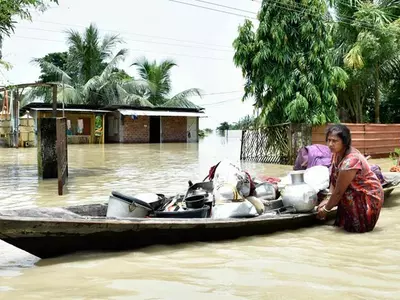Yesterday Once More: Why We Need A Long Term Solution To Floods That Occur Year After Year

Floods are a recurring event in several parts of India and the devastation that they bring too seem to be a repetitive saga wherein year after year a familiar pattern of havoc wreaked by rains come to the fore. So are we missing the signs by acting on a yearly basis rather than devising a long term plan to thwart the impact of this natural disaster?
At about this same time in 2018, one travelled to some of the remotest corners of Mizoram in the wake of Cyclone Mora that had hit Bangladesh and parts of Northeast India in June last year and while the sights were of apathy, the conversations with the locals who suffered first hand at the hands of the devastation revealed that it was not an isolated episode.

In fact, they asserted, the flood-prone regions witness similar fate on a yearly basis.
A year down the line and as similar headlines and heart-wrenching images grip our attention, one is drawn back, if only in memory -- fresh and vivid -- to the virgin woods in the Mizo hills that despite their natural beauty and untamed splendour are once again facing the same wrath of nature.
It is also a story of neglect at the hands of the state’s apathy that most parts of Northeast India are subjected to and this realisation strikes one quite early. Upon arriving at the Aizawl airport, one set on a road trip to the Tlabung subdivision, which is 2,802 feet above the sea level and 251 kms from the state capital.
This was among the worst affected areas last year but even in 2019 at least 5 people have lost their lives and over a thousand rendered homeless according to official figures.
It would not be difficult to imagine why if one were to consider the fact that the 251 km journey from Aizawl to Tlabung consumed a staggering total of over 16 hours of bumpy ride.
Most floods are sudden and the damage is utmost during the first few days but rescue operations as well as relief work is customarily delayed due to the poor state of roads in the Northeast.
Arriving in Tlabung then one learnt that the flood had struck the town like a thunder -- all too soon but far too severe -- in the middle of the night and before the inhabitants could even realise the water came rushing in to their homes, driving them out but carrying all their belongings into the Khawthlangtuipui river that separates India and Bangladesh.

The house of this family has been washed away by rain and they have still not been able to reconstruct it.
Thanks to an army camp that was located nearby, the town managed to brave the situation as members of the Indian army rose above their call of duty, swinging into action to build temporary shelters to those who had lost their homes. But even then, there was much more to be done and a sigh of relief came at least 15 days later as World Vision India, a Christian grassroots humanitarian organisation, reached on the ground to provide rice, dal, oil, salt, sanitary pads and silpaulin (a special type of tarpaulin) to those affected by the flood. This could have happened much earlier if only the logistics allowed.
While most parts of the main town was able to return to normalcy a month later when I arrived, the villages located on the banks of the river bore a devastated look even then and the scars of the flood remained still visible.
The havoc was unprecedented in Tablabagh village that has a population of about 1,500 and no significant relief had reached them even a month later. Most houses were submerged for a period of three days and while some survived after the flood, many had been washed away. Numerous families, such as that of Swana Chakma, who was a daily wage labourer, were still living with their relatives and had not been able to reconstruct their houses.
The scenario was replicated in another village, Serhuan, which is located across the river from Tlabung and was entirely submerged during the flash floods. But the villagers followed the footsteps of their ancestors, moving uphill with the rise of water level and taking refuge in temporary tents. When the floodwaters receded, they returned back, cut bamboo from the forest around them and began reconstructing their huts. And therein hangs another tale.
The reason behind such widespread devastation is the fact that the villages are located right next to the river bank and slightest of increase in water level poses a threat to their existence.
The Central government had announced a package of Rs 2,000 crore, followed by another package of Rs 300 crore in 2018, for the entire northeast for mitigating the impact of floods. There is no denying the fact that the state is investing its money into helping the affected people return to normalcy but what is missing is a concrete plan to look at the seriousness of the matter and to devise a roadmap to tackle this almost yearly disaster.
For example: The government spends its money to provide basic needs and to help reconstruct the houses that face the wrath of the flood but these houses are constructed on the exact same spot over and over.
They are located so close to the river that they are destined to doom every time the region witnesses an excess rain. The government has made attempts in the past to relocate the villagers, promising to build for them houses uphill but the villagers return to the river bank. Why?
“Because the land is very fertile and the river is the only mode of transport. We fear that If we stay uphill, people from across the border will steal our crops and also there is literally nothing that we can do in case of an emergency because there is no motorable road in the region. The river is everything,” Judu Ranjan Chakma, the president of the Young Chakma Association (YCA), had told this Correspondent in July 2019.
The villagers maintain that the process of rehabilitation to safer zones should be done while taking their livelihood and basic requirements into consideration. If their agricultural fields are next to the river, they will have no option but to live there too.
While this may be just one of the many facets that are behind this yearly devastation caused by floods in Mizoram, a detailed consultation with experts in devising a roadmap for a long term would go a much longer way in tackling this menace than a certain amount of relief fund announced on a yearly basis.

























